Cuba is a South American floral hotspot teeming with unusual and beautiful plant life. With so many stunning flowers to choose from, what have the Cubans settled on as their chosen floral emblem? It’s the fragrant white ginger lily! Let’s discover the national flower of Cuba, Hedychium coronarium, and find out why it was picked from so many potential contenders.

Cuba is a South American floral hotspot teeming with unusual and beautiful plant life.
©Victor Maschek/Shutterstock.com
What’s the National Flower of Cuba?
The national flower of Cuba is Hedychium coronarium, more commonly known as “white ginger lily” or “mariposa,” which means ‘butterfly‘ in Spanish due to its distinctive butterfly-shaped blooms.
Even though it is not a native flower, Hedychium coronarium runs wild in the mountains and spreads across the center of Cuba, covering the country with its exquisite jasmine-like perfume. Cubans say that a farmhouse is not a farmhouse without a mariposa plant in the garden. This flower is a national symbol and part of the everyday Cuban scenery.
Why Did Cuba choose Hedychium Coronarium?
National flowers are usually native species. For example, Honduras changed its national flower from a non-native rose to the better-suited native Rhyncholaelia digbyana orchid in 1969 to underline its independence from colonial rule. Still, Hedychium coronarium is not a Cuban native, so what’s up here?
Hedychium coronarium is native to India, but it’s become so common in Cuba that it’s one of the most frequently seen flowers there. It’s extremely beautiful with a heady, exotic fragrance, so it’s no wonder the Cubans fell in love with it.
It was introduced to Cuba from Asia in the 1500s, so it’s been there a long time, establishing itself in both wild and domesticated spaces. It’s so abundant now that Cuban women frequently wear its blooms in their hair as perfume and decoration.
But that’s not the whole reason why Hedychium coronarium is Cuba’s national flower!
During the Cuban wars of independence, Hedychium coronarium‘s deep flower inflorescences became an unlikely hiding place for secret messages! Just before the butterfly blooms break out, the inflorescences have deep, rounded sections perfect for disguising a short, hidden note.
So, even though it is not a native, the mariposa is integral to Cuba’s history and its fight for independence.

runs wild in the mountains and spreads across the center of Cuba, covering the country with its jasmine-like perfume.
©Tamu1500/Shutterstock.com
Is White Ginger Lily a Jasmine?
White ginger lily is another name for Hedychium coronarium. Despite its delicious scent, it’s not a jasmine but part of the ginger family.
Hedychium coronarium is also known as the flower of freedom, butterfly jasmine, and mariposa in Cuba. However, don’t confuse it with the mariposa lily, a North American native plant in the lily family.
Mariposa lily is a tulip-like three-petal white flower with a 20-inch stem that grows from a buried bulb. They are plentiful in California and easily spotted in grassland and verges because each petal has a purple dot that attracts pollinators.
Where Is Cuba?
The Republic of Cuba is an archipelago comprising Cuba island, Isla de la Juventud, and just under 4,200 small islands.
The main island is located south of Florida, east of Mexico, and west of Hispaniola in the northern Caribbean Sea. Its sea borders are the Caribbean Sea, the Gulf of Mexico, and the Atlantic Ocean.
The main Cuban island stretches over 42,426 square miles and has 11 million people living there, mostly in the capital city of Havana, Santiago de Cuba, and Camaguey.
Historians are puzzled by the name Cuba. Some experts think it’s derived from the indigenous Taino word cubao, which means “where fertile land is abundant,” or coabana, which means “great place.”
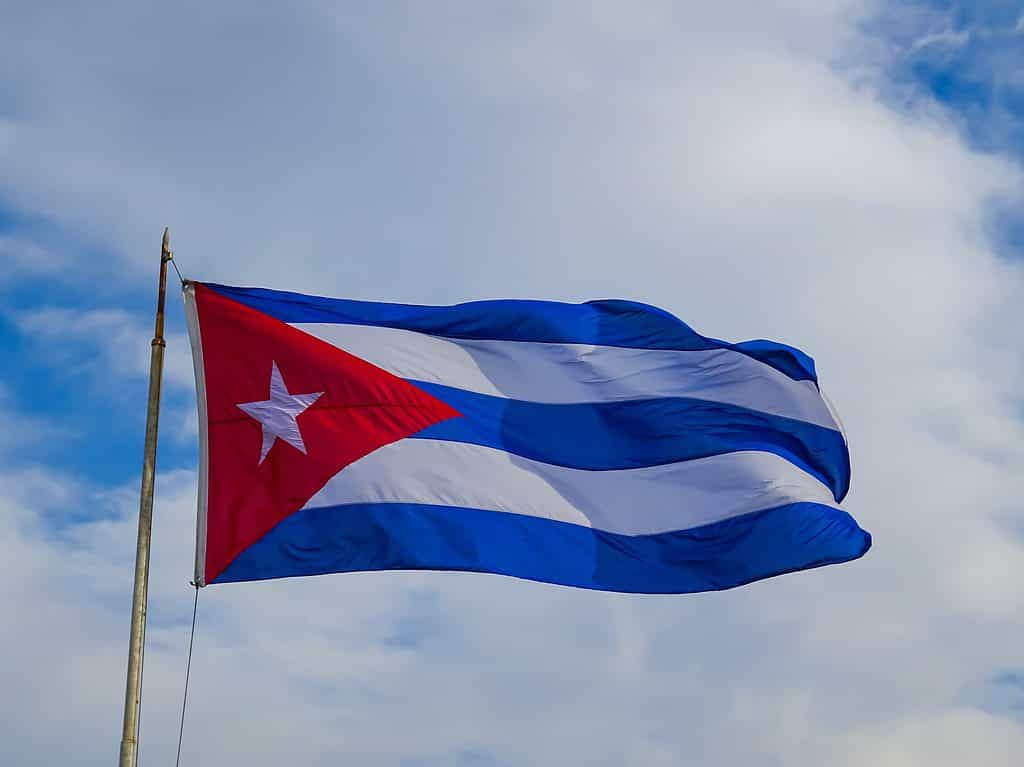
The name Cuba might derive from the Taino word
cubao, which means “where fertile land is abundant,” or
coabana, that is, “great place.”
©Giongi63/Shutterstock.com
Cuba’s Incredible Ecoregions
Cuba has a wide variety of ecoregions that are home to many species of plants and animals. The ecosystems are:
- Moist forests
- Dry forests
- Pine forests
- Wetlands
- Cactus scrub
- Mangroves
The smallest bird in the world, the 2.8-inch bee hummingbird, lives in Cuba’s forests, mountains, and swamps. Exotic flowers, including the national flower of Cuba, Hedychium coronarium, ensure there’s plenty of nectar for this tiny flying jewel.
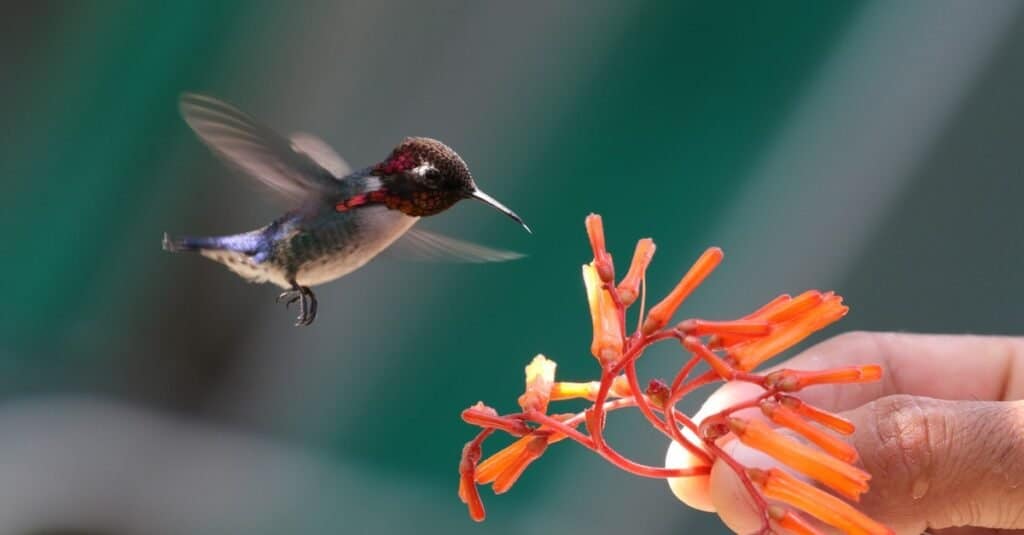
The smallest bird in the world, a bee hummingbird, drinks nectar from a plant held by a person in a hummingbird garden near Playa Larga, Cuba.
©James Bloor Griffiths/Shutterstock.com
Discover the National Flower of Cuba: Hedychium coronarium
Hedychium coronarium is a perennial plant in the Zingiberaceae ginger family. It is native to Asia and prefers forest understorey habitats.
The name Hedychium comes from two ancient Greek words: hedus, meaning ‘sweet,’ and chion, meaning ‘snow.’ ‘Sweet snow’ is an excellent name for this species because it has white, honey-scented flowers reminiscent of the ever-popular jasmine.

is a perennial plant in the
Zingiberaceaeginger family. It is native to Asia and prefers forest understorey habitats.
©YuRi Photolife/Shutterstock.com
Foliage
White ginger lily is an upright perennial plant, which means it dies back and grows again the following year but stays evergreen in tropical climates. It has long, pointed green leaves and reaches over nine feet tall. In colonial times, African slaves brought to Cuba by Spanish colonists slept on white ginger lily leaves.
Flowers
Hedychium coronarium is the national flower of Cuba, and its ability to conceal secret messages is one reason why, so let’s learn a bit more about it.
Hedychium coronarium has white, sweetly scented, butterfly-shaped flowers gathered on a thick, green, hollow inflorescence. The petals have pale yellow centers that attract pollinators and feel a little waxy.
In its native Asia, Hedychium coronarium blooms from August to December, and it’s roughly the same in tropical areas of Cuba. Butterflies, moths, flies, beetles, and the tiny bee hummingbird pollinate white ginger lily flowers.
Growing Zones
Hedychium coronarium is a rhizomatous plant that spreads beneath the ground and throws up nutrient-storing pseudo stems. It’s spreads quickly in damp areas and is invasive in several places, including Rio de Janeiro and Bahia.
In the late 1800s, Chinese immigrants took hedychium coronarium to Hawaii, but it’s now become a serious nuisance there. South Africa and New Caledonia also struggle with invasive mariposa. It’s such a problem in South Africa that propagating it is illegal.
How to Grow Hedychium Coronarium
Be extra sure you want to grow Cuba’s national flower because once it starts, it’s difficult to get rid of due to its strong water-seeking rhizomes.
Hedychium coronarium is evergreen in warm Cuba and USDA zones 8-11, but in colder states and northern Europe, it will lose its leaves in winter, survive sub-zero temperatures, and re-merge in spring.
Choose consistently moist but not soggy soil for white ginger lily. It prefers humidity, but it can survive without it if its roots are sufficiently damp. Place in part sun to full sun to make sure its flowers bloom.
White ginger lily grows happily in a well-watered and fed container. In fact, a sunken root-restricting container is a great way to grow Hedychium coronarium near waterways and ponds to prevent its roots from running wild and causing an invasive nuisance.
Cuba’s Beautiful Native Flowers
The national flower of Cuba, Hedychium coronarium, is just one of its glorious blooms. It was chosen as the national flower because secret wartime notes could be hidden in its inflorescence. Here are some of the other beautiful Cuban flowers that grow alongside mariposa.
Marcgravia evenia
This pretty flowering rainforest vine is endemic to Cuba. It’s an example of animal-plant co-evolution because its flowers are adapted to encourage pollinating Cuban flower bats.
Marcgravia evenia flowers are fluffy blooms in a circle above its disc-shaped leaves below. These leaves act as a reflector for echolocation, so when bats emit signals, they bounce back to pinpoint their location. The blossoming buds are deep, so bats’ tongues can reach deep inside and pull out lots of nectar.
Heliconias
Heliconias are perennial tropical plants with long, strappy leaves and big, showy flowers. Bright waxy bracts actually surround the flowers. They bloom in a wide variety of colors, including reds, oranges, and yellows.
Heliconias are popular plants in many tropical areas but native to South America.
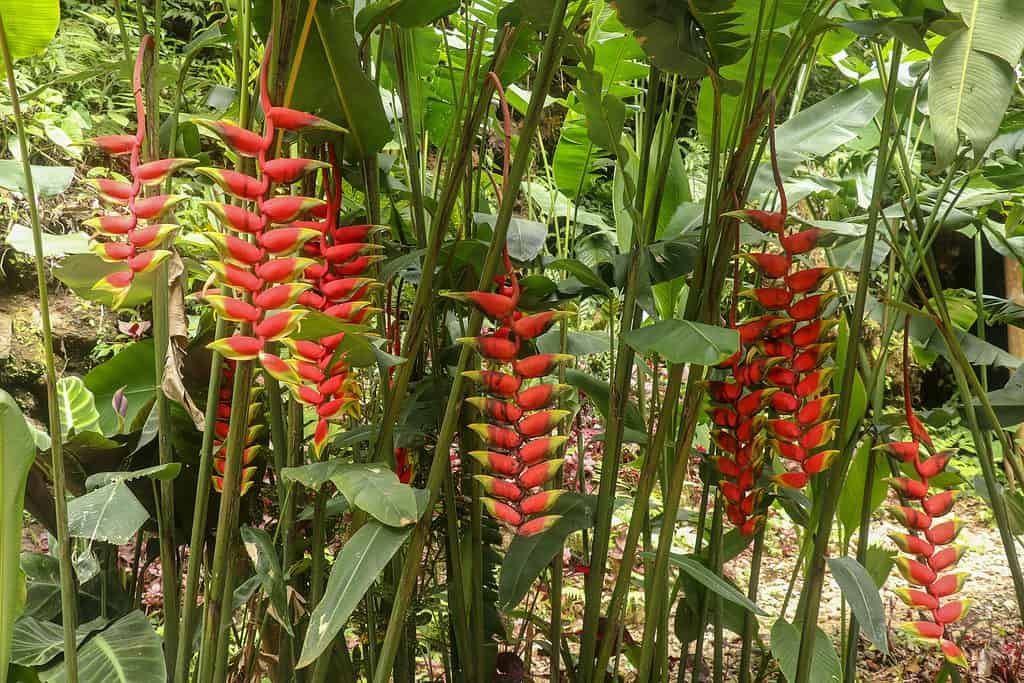
Heliconia is a perennial plant related to the bird-of-paradise plant, and it’s native to Bolivia, Peru, El Salvador, Costa Rica, and Ecuador.
©Sanatana/Shutterstock.com
Golden Chalice Vine (Solandra longiflora)
The tropical cup-of-gold vine is native to Cuba, Hispaniola, and Jamaica. It has glossy green leaves on huge vines that can reach 40 feet in length amid tall rainforest trees. Its key feature is its six-inch-diameter blooms, which resemble yellow wine glasses.
The flowers are night-scented and primarily pollinated by moths and bats.
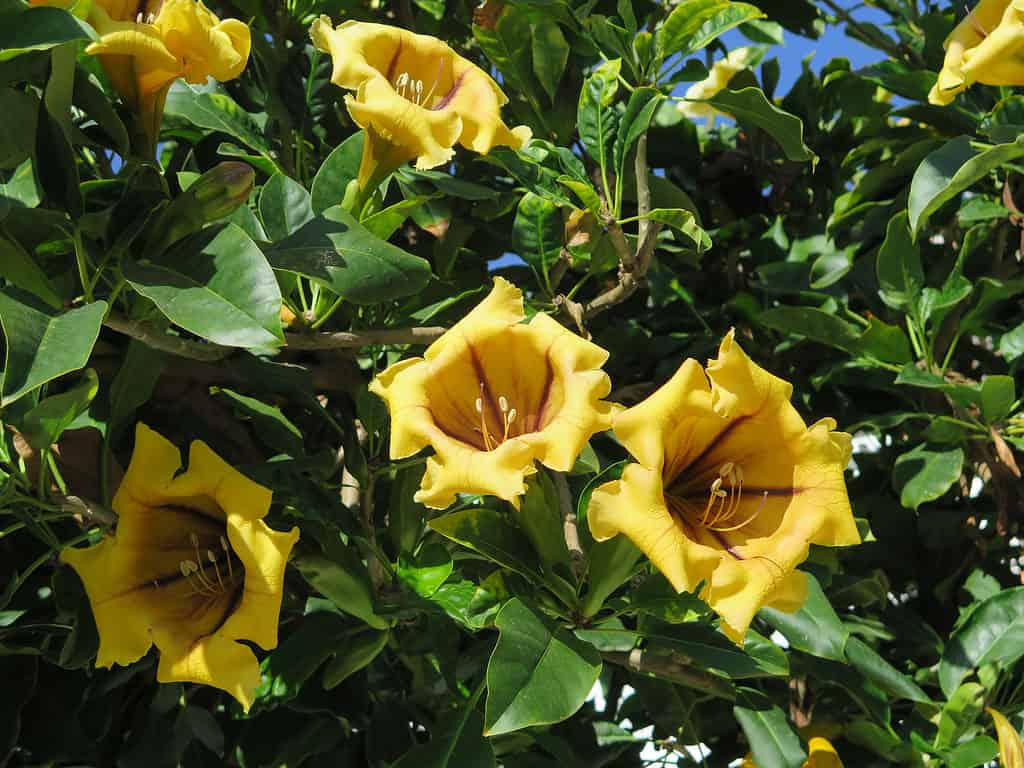
The tropical cup-of-gold vine is a Cuban, Hispaniolan, and Jamaican native.
©Hans wrang/Shutterstock.com
Yellow Morning Glory (Distimake aureus)
Another yellow flowering beauty native to Cuba is yellow morning glory, also known as yuca vine. It’s a 16-foot-long vine native to tropical areas with masses of bell-shaped yellow flowers.
The flowers are beautiful, but the seeds are really unusual. They turn into “wood roses,” which are popular in flower arrangements, hence its alternative name, yellow wood rose.
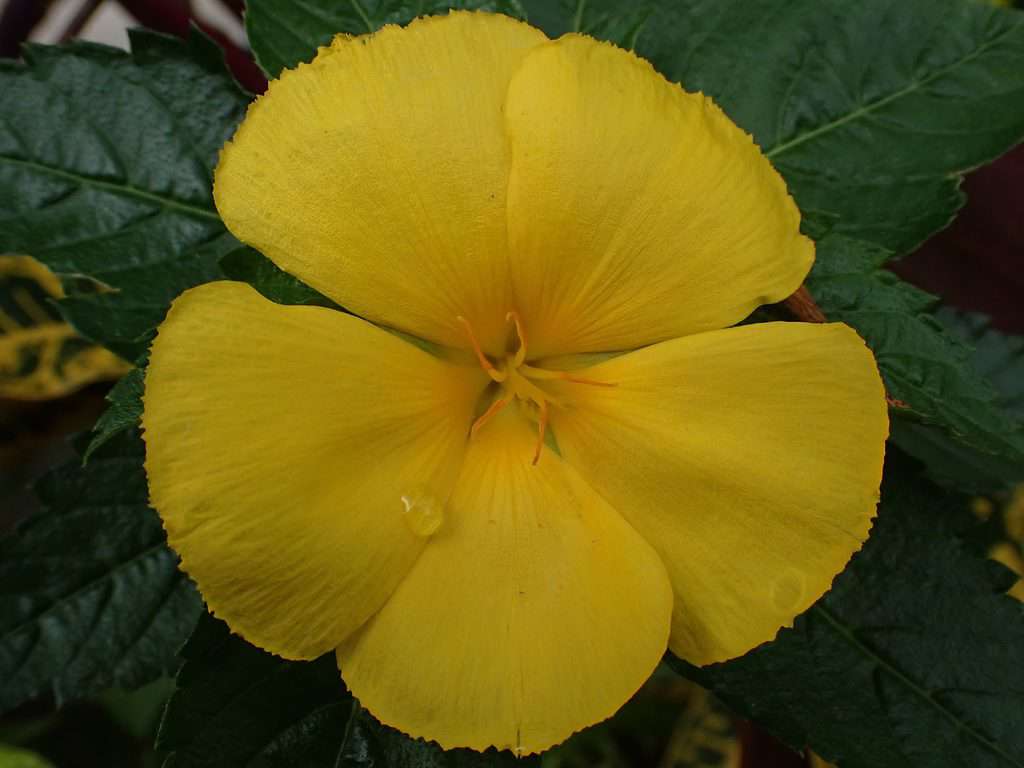
The morning glory is a 16 feet long vine native to tropical areas with masses of bell-shaped yellow flowers.
©Jose Mar Magtagad/Shutterstock.com
The photo featured at the top of this post is © Ricardo de Paula Ferreira/Shutterstock.com
FAQs (Frequently Asked Questions)
What is the national flower of Cuba?
The national flower of Cuba is hedychium coronarium. It’s more commonly known as white ginger lily or mariposa, which is Spanish for butterfly, due to its distinctive butterfly-shaped blooms.
What is so significant about the Hedychium coronarium?
During the Cuban wars of independence, hedychium coronarium’s deep flower inflorescences became an unlikely hiding place for secret messages! Their inflorescences have deep rounded sections just before the butterfly blooms break out, which are perfect for disguising a short, hidden note.
Thank you for reading! Have some feedback for us? Contact the AZ Animals editorial team.






